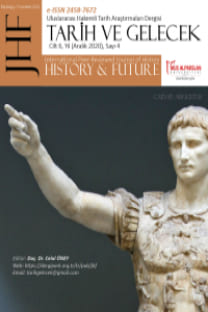George Orwell’in Hayvan Çiftliği Romanında Din İstismarı Eleştirisi
Rus Ortodoks Kilisesi, din, din istismarı, Bolşevik Devrimi
The Criticism of Abuse of Religion in the Novel of Animal Farm by George Orwell
Russian Orthodox Church, religion, abuse of religion, Bolshevik Revolution,
___
- Addicott, Jeffrey F. ‘The Misuse of Religion in the Global War on Terrorism’. Barry Law Review 7 (2006): 109.
- Apaydın, H.Yunus. İlmihal-II-İslam ve Toplum. 21st ed. Vol. II. Ankara: Türkiye Diyanet Vakfı Yayınları, 2013.
- Batar, Yusuf. ‘“Dini” Manipülasyonlar Karşısında İmam Hatip Okullarının Misyonu’. Journal of Education in Muslim Societies and Communities, 2017.
- Bradford Telegraph and Argus. ‘Bishop “Outraged” after Tear Gas Used on Crowds before Trump Church Photo Op’. Accessed 29 March 2021. https://www.thetelegraphandargus.co.uk/news/national/18489990.bishop-outraged-tear-gas-used-crowds-trump-church-photo-op/.
- Certel, Hüseyin. ‘Din İstismarı Üzerine’. Journal of Islamic Research 22, no. 1 (2011).
- Çiftçi, Adil. ‘Din Istismarı: Kavramsal ve Kuramsal Bir Çalışma-Sosyolojik Bir Yaklaşım’. İslamiyat III, no. III (2000).
- Çi̇ftci̇, Gülden. ‘Kitap İncelemesi: Animal Farm (Hayvan Çiftliği)’. Journal of International Management, 2013, 2. Davis, Nathaniel. ‘A Long Walk to Church: A Contemporary History of Russian Orthodoxy’. (Westview Press, Boulder, Co., 1995.
- Dickinson, Anna. ‘Quantifying Religious Oppression: Russian Orthodox Church Closures and Repression of Priests 1917‐41’. Religion, State and Society 28, no. 4 (1 December 2000): 327–35. https://doi.org/10.1080/713694776.
- Dualı, Şir Muhammed. ‘Siyasetin Dine Etkisi Bağlamında Stalin’in Kilise Politikaları’. Cumhuriyet İlahiyat Degisi 21, no. 2 (2017).
- Fi̇dan, İsmail. ‘Hayvan Çiftliği’. Van Yüzüncü Yıl Üniversitesi İktisadi ve İdari Bilimler Fakültesi Dergisi 3, no. 6 (30 December 2018): 184–89.
- Guocheng, Ma. ‘Symbolism in the Absurdity of Animal Farm’. The Frontiers of Society, Science and Technology 2, no. 3 (22 May 2020). https://doi.org/10.25236/FSST.2020.020308.
- Inch, James. Communism and the Betrayal of the Revolution : A Marxist Critique of the Post-Revolutionary Manipulation of the Proletariat in Animal Farm, 2016. http://urn.kb.se/resolve?urn=urn:nbn:se:hig:diva-23167. Kenworthy, Scott M. ‘Rethinking the Russian Orthodox Church and the Bolshevik Revolution’ 31, no. 1 (2018). https://doi.org/10.1080/09546545.2018.1480893.
- Marx, Karl. Hegel’in Hukuk Felsefesinin Eleştirisi. Translated by Kenan Somer. 2nd ed. Ankara: Sol Yayınları, 2009.
- ........................Opalinska, Wanda. Animal Farm. York Press, 2010.
- ...........................Orwell, George. Animal Farm. Penguin Books, 1951.
- Orwell, George, and Russell Baker. Animal Farm: 75th Anniversary Edition. 50th Anniversary edition. New York, NY: Signet, 2004.
- Öztürk, Yaşar Nuri. ‘İnsanlık komünizmi yeniden sahneye çağıracaktır!’ http://www.aydinlikgazete.com/, 2015.
- https://www.aydinlikgazete.com/insanlik-komunizmi-yeniden-sahneye-cagiracaktir-makale,61635.html. Reese, Roger R. ‘The Russian Orthodox Church and “Patriotic” Support for the Stalinist Regime during the Great Patriotic War’. School of Humanities & Social Sciences, The University of New South Wales, 2014. https://doi.org/DOI 10.1179/0729247314Z.00000000035.
- Şimşek, Gülsüm. Reklam Etiğinde Din İstismarı Örnek Olay İncelemesi, 2016.
- Russiau. ‘The Cathedral of Christ the Saviour of Moscow: You Will Not Believe Its Story’, 30 January 2019.
- https://russiau.com/cathedral-christ-saviour-moscow/.
- Walters, Philip. ‘The Russian Orthodox Church and the Soviet State’. The ANNALS of the American Academy of Political and Social Science 483, no. 1 (1 January 1986): 135–45. https://doi.org/10.1177/0002716286483001012. Welle (www.dw.com), Deutsche. ‘How Churches in the Soviet Union Were Desecrated and Repurposed | DW | 22.09.2016’. DW.COM. Accessed 3 February 2021. https://www.dw.com/en/how-churches-in-the-soviet-union-were-desecrated-and-repurposed/g-19565103.
- Yalçın, Durmuş, Yaşar Akbıyık, and Gülnihal Bozkurt. Türkiye Cumhuriyeti Tarihi II. Ankara: Atatürk Araştırma Merkezi, 2011.
- Yayın Aralığı: Yılda 4 Sayı
- Başlangıç: 2015
- Yayıncı: Celal ÖNEY
Sultan II. Mahmud Dönemi Sikkeleri ve İznik Müzesi’nden Örnekler
Trabzon İngiliz Konsolosu Vorley Harris’in Raporlarına Göre 1950’li Yıllarda Rize
Ortaçağda Dristian Rahiplerinin Noterler ve Hakimler Olarak Rolü
Afrika Kıtasında Nilotik Bir Halk: Dinkalar ve Geleneksel Dinka Dini
Dubrovnik Devlet Arşivinde Bulunan Ortaçağ Arnavutlarına İlişkin Kaynak Belgeler
Abdurrahman Âdil (Eren)’in Osmanlı Matbûat Âlemine Dair Hâtıraları
1946 Belediye Seçimleri ve Urfa’daki Yansımaları
Sosyal Adaletsizliğe Karşı Romantik Yazarlardan İdeal Toplum Görüşleri: Devrimin Farklı Yorumu
